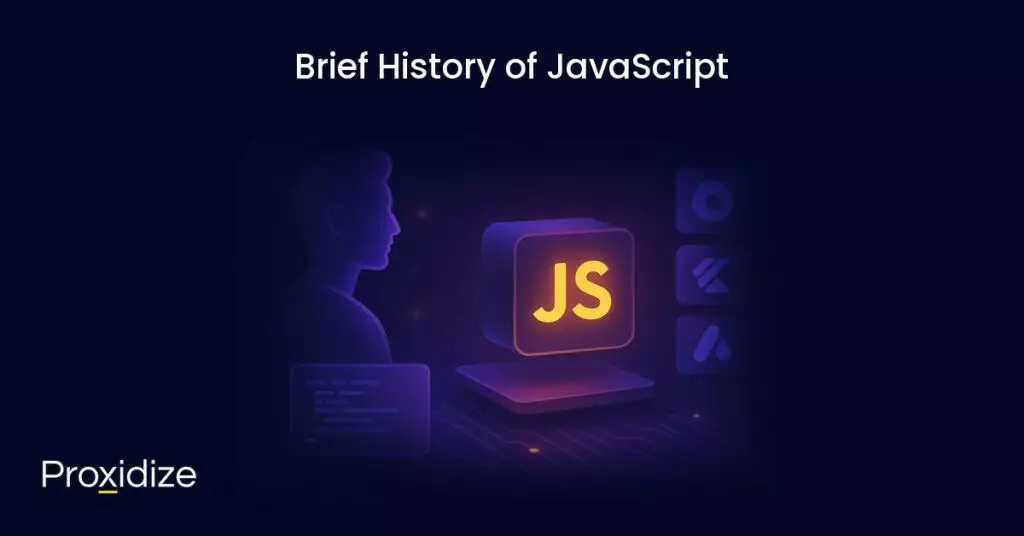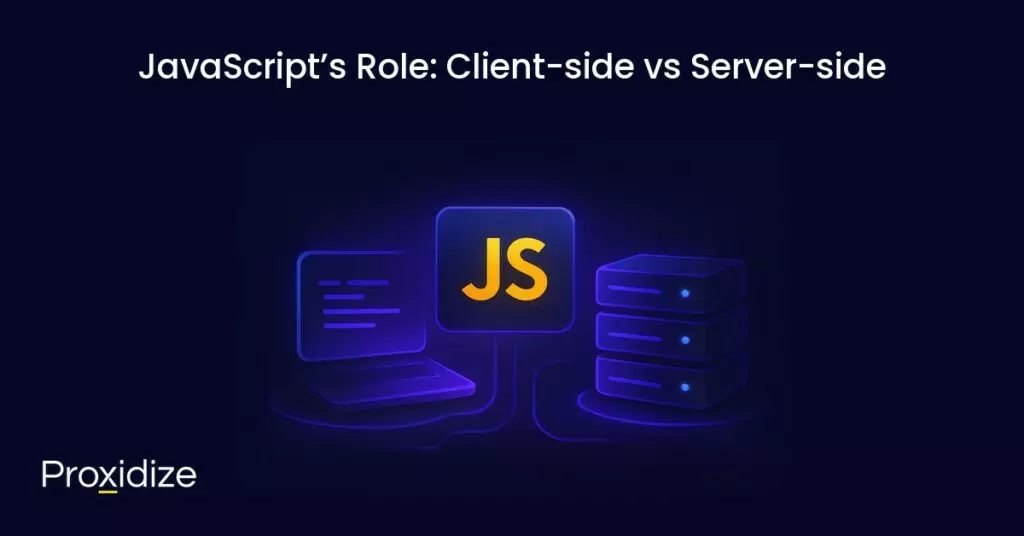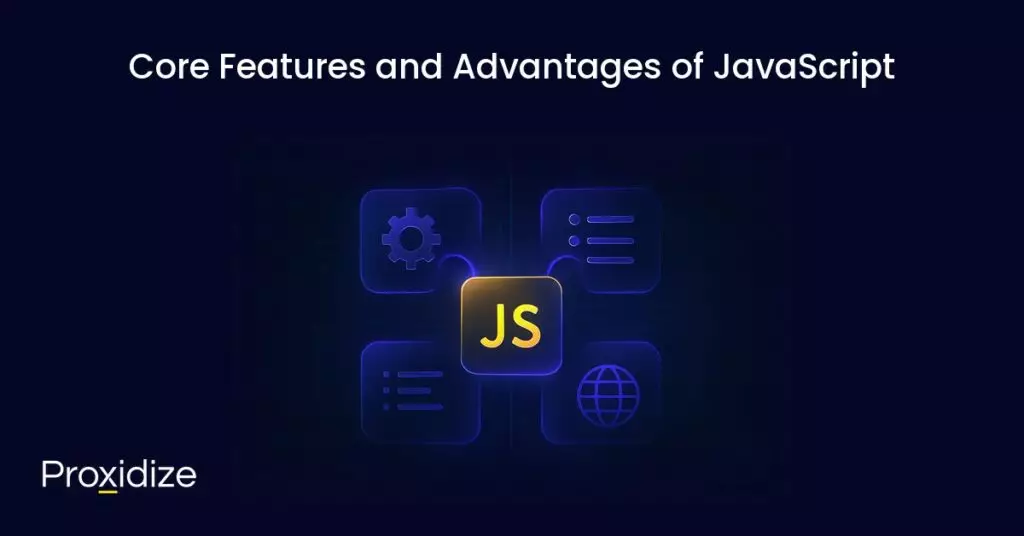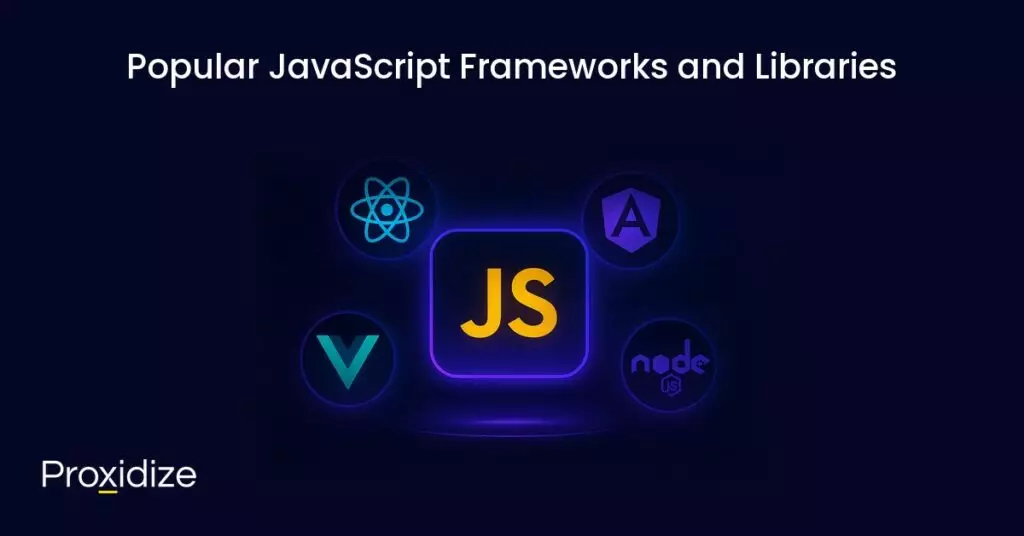JavaScript is one of the most widely used programming languages in the world, along with markup languages such as HTML and CSS, The main purpose of JavaScript is to add functionality to your website, in other words make your website alive. Back in the day websites were static and then JavaScript showed up and solved this problem.
In this article we will talk all about JavaScript. We will start with how it works on the client and server side, JavaScript’s features, and how to use it in proxies. Then we’ll talk about JavaScript’s little (better) brother, TypeScript.

Brief History of JavaScript
JavaScript was created in May 1995 by someone called Brendan Eich who worked at a company called Netscape. He created the language in 10 days, although it was originally called Mocha. Its name quickly changed to Livescript and, later, JavaScript.
As we touched on, websites were originally static. JavaScript allowed this to change and played a key role in the rapid development of the web we know today.
JavaScript’s syntax is inspired from Java, its first-class functions inspired by Scheme, and its prototype-based inheritance borrowed from Self. Since then, JavaScript has changed the world of development dramatically, websites’ front-end development in particular where it’s made interacting with websites more enjoyable and easier.
Now it’s being used in React.js, Nextjs, and Vuejs, which are currently the most used frameworks. It’s also being used in platforms such as framer where they create interactive content based on JavaScript.

JavaScript’s Role: Client-side vs Server-side
JavaScript is so powerful that it’s used both on client side and server side, which is a real testament to the language’s flexibility and wide-spread adoption among developers.
Client-Side JavaScript
When we talk about the client side, it’s everything the user sees on their screen while interacting with a website or mobile application. When a user visits a page, the HTML, CSS, and JavaScript files are downloaded via their browser and the JavaScript code is executed within the browser environment.
By doing this the dynamic and interactive content, such as form validation, antimotes, and content get updated without the web page having to reload, because the code is running on the client’s end.
Having the code running on the client side is very good and helpful, but the client side code will be exposed and by that it’s easy to manipulate the code, that’s why I recommend not to handle any sensitive data or logic.
Sever-Side JavaScript
This is where all the magic happens, the complex logic, dealing with sensitive data, the server-side code, obviously from the name it runs on the server.
Languages such as Node.js allow JavaScript to run on the servers. It handles database operations, user authentication, as we mentioned the server-side is on the server so the user can’t access nor modify it, the user just enters the page and once he enters a request is made from the client side to the server side to bring any data required.
Key Differences
- Execution: Client-side runs on the user’s device , meanwhile the server-side runs on the server.
- Use Case: Client-side is used for interfaces and interaction, meanwhile the server-side is used for handling complex logic.
- Security: Never use client-side for sensitive information, instead use the server-side for this kind of stuff.
So by using the client-side and the server-side developers can build scale tools and the beauty of JavaScript if it was used for both server-side and client-side you will have a very good eco-system to work with since they are both JavaScript syntax.

Core Features and Advantages of JavaScript
JavaScripts’ core features and advantages makes it one of first choices for developers, since the developers are always looking for easy, maintainable and widely supported language.
Core Features
- Lightweight: JavaScript is incredibly light which makes it efficient and a go-to when speed and performance is required.
- Dynamic Typing: In JavaScript you have the freedom to create any value without having to specify what type of value it is on the spot. It just gets declared in the runtime, which can help speed up development.
- Asynchronous: JavaScript supports async/await, callbacks, and promises, which allows for the flexibility needed to deal with complex operations.
- Event-Driven: JavaScript can be used to detect and respond to users’ actions like mouse movements and clicks, which makes it particularly useful for animation-related activities, among others.
- Compatibility: JavaScript is compatible with every browser and device, which makes it a natural choice for website and mobile app development.
Advantages
- Full-Stack Development: JavaScript works on both the server-side and the client-side, which gives developers access to a rich ecosystem.
- Widely Used and Supported: It’s one of the most used programming languages in the world, which means there are lots of communities, nearly endless resources to learn from, and many tutorials — ideal for beginners to get started.
- Open Source: JavaScript is open source, which means developers know exactly how it works internally. It also means that developers have built a huge ecosystem of other open source tools, libraries, and frameworks around it.
- Saves Time and Bandwidth: JavaScript always executes the code on the client-side which means fewer resources are required on the server side — ideal for speed and efficiency.
If you want to build a great product but you also want a great ecosystem and make use of the community support available, JavaScript should be your first choice.

What Is JavaScript Used For?
Since JavaScript can run both on web and mobile platforms, the use cases are essentially limitless:
- Game Development: JavaScript with HTML5 is a good combination for creating browser based games; developers use libraries such as EaselJS that makes it easier to create games.
- Web Applications: As we mentioned JavaScript can be used to build client and server-side applications which makes it ideal for full-stack web development.
- Browser Extension: JavaScript enables us to build extensions for browsers such as Chrome and Firefox, which add functionality and interactivity to it.
- Mobile Applications: Frameworks such as React Native enables developers to write code for mobile applications using JavaScript, which makes it the ideal choice for developers who are used to the language.
- Web Scraping: We can use JavaScript for web scraping, as we mentioned nodejs can be used in the server-side which helps in web scraping. Combining Node.js with Puppeteer or Selenium is a great choice.
- Headless Browsers: JavaScript can be used in headless browsers which run browsers without a graphical user interface to automate tasks or web scraping.
- Web Automation: JavaScript is widely used with frameworks like Selenium for web automation, which enables scripts to mimic human behavior when interacting with browsers; everything from logging in, filling forms, and clicking buttons or links.
- Browser Fingerprinting: JavaScript can be used to collect detailed data browser and device attributes. That data can be used to create unique browser fingerprints, which can be used in user analytics, personalization and fraud detection.
If you are building for a web application or mobile application JavaScript can play a vital role in its amazing ecosystem.

Popular JavaScript Frameworks and Libraries
In recent years, JavaScript’s popularity has increased a lot among developers. This has led to the creation of many amazing frameworks that not only save time and money but enables us as developers to build more efficiently and more scalable products as well.
The following are some of the most famous frameworks and libraries for 2025:
- React.js: A library, created by Facebook, most famous for building user interfaces that contain single-page applications. It’s the ideal library for building scalable component-based systems.
- Next.js: A framework built on top of React.js. Next.js makes loading a website incredibly fast for users, as it loads the website’s images and content on the server side then sends it to the client side.
- Node.js: Used in server-side code, Node.js is used for things like authentication and database logic. Together with npm, Node.js is one of the most used languages on the server-side.
- Angular: A framework built by Google; the main use of it is to build user interfaces. Angular is TypeScript first, and its large community and unified ecosystem means it’s perfect for large-scale projects.
- SolidJS: A programming language model with fine-grained reactivity and with no virtual dom. It’s very fast and learning SolidJS is an easy transition for developers who already use JavaScript.
As you can see, JavaScript has many frameworks and libraries that are great for builders, allowing you to save yourself a lot of time and money when developing your applications.

TypeScript: JavaScript’s (Better) Little Brother
Programming languages evolve like all other software and technology. JavaScript is no exception; Microsoft first introduced TypeScript in 2012 with the intention of adding improvements.
TypeScript added structure, safety, and tooling features. The introduction of optional static typing and clearer code structure meant that more complex code could be more easily managed.
Why Developers Are Using TypeScript
- Compatibility: TypeScript was originally created to make developers’ life easier — any JavaScript code is valid TypeScript code, which makes it easy to transition to.
- Error Prevention: TypeScript catches common errors during the compilation not on the runtime, which makes it ideal to catch errors fast and prevent any failed builds.
- Increased Productivity: TypeScript can reduce time for developers since it’s supported by all IDEs as well as by the AI wave. It makes life easier because a developer can understand at a glance what to pass to a function.
- Scalability: Spending a lot of time working on one codebase can give you a headache. TypeScript lets you create types and rules that help make the code more efficient and helps standardize the code for the whole team.
TypeScript saves developers time and effort, which is why it’s described as JavaScript’s little, better, brother.
Conclusion
JavaScript remains a favorite among developers because of its rich ecosystem and because it serves both server-side and client-side. This makes it ideal for full-stack applications. Every dynamic website has JavaScript to thank for not looking like it came straight out of the 90s. On top of that, JavaScript has features that make it great for a wide range of use cases like web scraping and automation. The bottom line is that JavaScript is lightweight and easy to learn.
Key Takeaways:
- JavaScript can be used both for front-end and back-end development.
- JavaScript is one of the easiest programming languages to learn and use because there are so many tutorials and resources online.
- JavaScript has frameworks and libraries that are widely used like React.js and Node.js.
- JavaScript is used for everything from mobile applications to web automation and beyond.
- TypeScript took everything great about JavaScript and made it even better, and the transition for developers is easy.
JavaScript is a mature language and has a rich ecosystem and since it’s open-source, many complex problems have already been solved by other people, making more ambitious projects easier to start. Finally, TypeScript takes everything great about JavaScript and makes it better in terms of variable type and it just makes life easier for developers and large scale projects.
Frequently Asked Questions
How to learn JavaScript?
The best way to learn any programming language, not just JavaScript, is to decide on a project you want to tackle and then learn how to complete each step. Use whatever resources work best for you, whether that’s YouTube videos, how-to articles, Reddit communities, and more.
What does JavaScript do?
The main purpose of JavaScript is to add interactivity to the website to make it more unique and appealing. A well-designed website will always help you increase traffic and user retention.
How long does it take to learn JavaScript?
It depends on the time and effort you invest in learning it. Some people learn very quickly, applying different concepts in new contexts with each project. Others might take longer, until they find a study medium that works for them.
Is Java and JavaScript the same?
No, Java and JavaScript are two distinct programming languages. JavaScript’s syntax was inspired by Java, but both languages are very different. Java is statically typed and it’s mainly used on the sever side. By contrast, JavaScript is dynamically typed and is widely used for both server side and client side.
When was JavaScript created?
It was created in 1995 by Mozilla project co-founder Brendan Eich while he worked at Netscape. He claims that he created the language in just 10 days!
Is JavaScript object oriented?
Yes, JavaScript is an object-oriented language. It has objects such as inheritance, encapsulation, and aggregation.
Why is JavaScript in HTML?
JavaScrip works well with markup languages HTML and CSS. The three together helped create the interactive websites that are standard today but were unthinkable in the early 90s.




